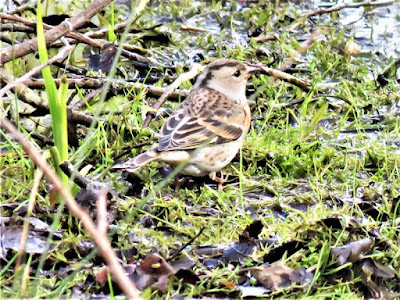There were three Shelduck present, two of which were drakes – with the predictable result of conflict. Here sparring.
And here they crash in to the water forcing a duck Tufted Duck to flee in panic!
One on fly-by.
Four drake Shoveler in pursuit of a single duck.
Now five drakes in pursuit. This would be classified as harassment in our world.
This is a reminder of what our familiar (Common) Teal look like. Note the horizontal white line on the drake and the yellow border around the green area on its cheek.
Depending upon the way the bird folds its wings the white line can be more or less hidden. The strength of the yellow border on the face is rather variable.
A surprise find was this New World equivalent: a drake Green-winged Teal. This lacks the horizontal white line but instead shows a vertical white line on the front of the flanks. The yellow bordering the green on the face is typically much reduced. The bird was typically shy and stayed well away from the viewing areas. The name is not especially illuminating as both species have a green speculum in the wing. This is only my second-ever sighting of this species in the UK, my previous sighting being here about six years ago. The ducks of these two species are very difficult to separated.
A Little Ringed Plover enlarged as much as I dare. It is smaller than the similar (Great) Ringed Plover, most easily separated by having an obvious eye ring and pale legs. In flight it is one of the few small waders that show no white in the wing. Two birds had dropped in here but were soon on their way, departing high to the North.
"I'm bigger than you – out of my way". An arriving adult Lesser Black-backed Gull scatters a loafing group of Black-headed Gulls.
A stately Grey Heron.
And now flies by scattering a first year Black-headed Gull.
Not much to see at the woodland feeders. This Great Spotted Woodpecker was lurking. A male with the red on the nape. Here the eye is covered by its nictating membrane. This third eye-lid is possessed by many birds. It is translucent and enables them to maintain some vision while protecting and moistening the eye. A Blue Tit in the background.
This female Brambling was welcome. She lacks both the black head and the orange shoulders of the male.
(Ed Wilson)














